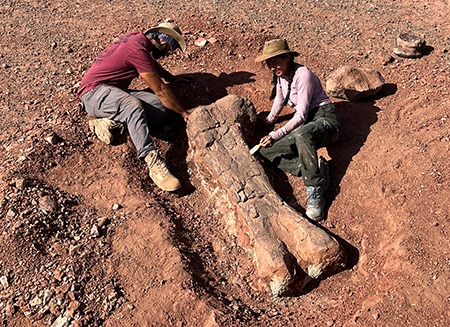
Paleontology is a fascinating field that explores the history of life on Earth through the study of fossils. Fossils provide invaluable insights into ancient organisms, their environments, and the evolutionary processes that have shaped the diversity of life we see today. From the remarkable preservation of insects in amber to the iconic Tyrannosaurus rex, the world of paleontology is filled with intriguing facts and discoveries. In this overview, we will delve into some interesting trivia about paleontology, highlighting the tools, techniques, and significant findings that have advanced our understanding of prehistoric life.
First Paleontologist: The term “paleontology” was coined in 1822 by the French naturalist Jean-Baptiste Lamarck, who is also known for his early theories on evolution. Paleontology, derived from the Greek words “palaios” (ancient), “ont” (being), and “logos” (study), encompasses the study of ancient life through the examination of fossils. Lamarck’s contributions to the field laid the groundwork for future paleontological research, although his ideas on evolution were later refined by Charles Darwin. The establishment of paleontology as a scientific discipline marked a significant shift in our understanding of Earth’s biological history.
Oldest Dinosaur Fossil: The oldest known dinosaur fossils date back to approximately 230 million years ago, during the Late Triassic period. These fossils represent some of the earliest members of the dinosaur lineage, showcasing primitive features that would evolve over millions of years into the diverse array of dinosaurs that roamed the Earth. Discoveries in regions such as Argentina and the southwestern United States have revealed fossils like those of the small, bipedal dinosaur, Eoraptor, which provides insight into the characteristics of early dinosaurs and their environments.
Largest Dinosaur: Argentinosaurus is considered one of the largest dinosaurs, estimated to have weighed up to 100 tons and measured around 100 feet long. This massive sauropod lived during the Late Cretaceous period in what is now Argentina. Its enormous size is thought to be an adaptation for reaching high vegetation and deterring predators. The sheer scale of Argentinosaurus has made it a subject of fascination in paleontological studies, and its remains have contributed to our understanding of the diversity and evolution of giant dinosaurs.
Smallest Dinosaur: The smallest known dinosaur is the Microraptor, which was about the size of a crow, measuring approximately 2.5 feet in length. This small, feathered dinosaur lived during the Early Cretaceous period and is notable for its unique morphology, which included long feathers on its arms and legs, suggesting it was capable of gliding or possibly even powered flight. Fossils of Microraptor have been found in China, and its discovery has provided significant evidence for the evolutionary link between dinosaurs and modern birds, highlighting the diversity of body sizes and adaptations in the dinosaur lineage.
Fossil Record: The fossil record contains over 250,000 described species of fossils, with many more yet to be discovered. This extensive collection of preserved remains offers a window into the history of life on Earth, documenting evolutionary changes over millions of years. Fossils can range from the remains of large vertebrates to microscopic organisms, providing insights into past ecosystems and climate conditions. Paleontologists utilize this vast repository of information to reconstruct ancient environments, understand extinction events, and trace the lineage of various species.
First Dinosaur Discovery: The first scientifically recognized dinosaur fossil, Megalosaurus, was described in 1824 by William Buckland. This carnivorous dinosaur was found in England and was one of the first to be identified as a distinct group of reptiles. Buckland’s work marked a pivotal moment in paleontology, as it initiated formal scientific inquiry into dinosaurs. The discovery of Megalosaurus spurred further exploration and research, ultimately leading to the identification of numerous other dinosaur species and the establishment of paleontology as a legitimate scientific discipline.
Longest Dinosaur: The longest dinosaur known is the Argentinosaurus, with estimates suggesting it could reach lengths of over 130 feet. This giant sauropod is not only remarkable for its length but also for its massive body structure, which included a long neck and tail. Its size likely provided advantages in foraging for food high in trees and in avoiding predators. Fossil evidence indicates that Argentinosaurus lived in herds, which may have offered protection against large carnivorous dinosaurs. The study of such enormous creatures continues to intrigue scientists and the public alike.
Most Expensive Fossil: A T. rex skeleton sold for $8.36 million at auction in 2020, making it one of the most expensive dinosaur fossils ever sold. This particular specimen, known as “Stan,” was discovered in South Dakota and is notable for its completeness and well-preserved bones. The sale reflects the growing interest in paleontology and the market for dinosaur fossils, which can fetch high prices due to their rarity and scientific significance. The auction of Stan not only highlights the financial value of such fossils but also raises questions about the ethics of fossil trading and the importance of preserving these scientific treasures for research and education.
Paleontologist Education: Most paleontologists hold advanced degrees, with many having a Ph.D. in paleontology or a related field. This educational path typically involves extensive study in geology, biology, and evolutionary science, often including fieldwork and laboratory research. Aspiring paleontologists usually start with a bachelor’s degree in a relevant discipline, followed by a master’s or doctoral program that emphasizes specialized topics such as vertebrate paleontology, invertebrate paleontology, or paleoecology. Graduate studies often involve conducting original research, publishing findings, and participating in fossil excavations. The rigorous educational requirements reflect the complexity of the field, as paleontologists must possess a deep understanding of many scientific principles to analyze fossils and interpret ancient ecosystems accurately.
Fossilization Process: Fossilization can take thousands to millions of years, depending on environmental conditions and the type of organism. The process typically begins when an organism dies and is quickly buried by sediment, which protects it from decay and scavengers. Over time, minerals in the surrounding sediment infiltrate the remains, gradually replacing organic material and creating a fossil. Conditions such as low oxygen levels, rapid burial, and the presence of minerals are crucial for successful fossilization. Different types of fossils, including body fossils, trace fossils, and chemical fossils, can form through various processes, providing a wealth of information about the organism’s life and the environment in which it lived. Understanding fossilization is essential for paleontologists as it helps them interpret the fossil record and reconstruct past life on Earth.
Dinosaur Extinction: The mass extinction event that wiped out the dinosaurs occurred around 66 million years ago, likely due to an asteroid impact. This catastrophic event, known as the Cretaceous-Paleogene (K-Pg) extinction event, resulted in the loss of approximately 75% of Earth’s species, including all non-avian dinosaurs. Geological evidence, including a layer of iridium-rich clay found in the fossil record, supports the asteroid impact hypothesis, specifically at the Chicxulub crater in Mexico. The aftermath of the impact likely caused drastic climate changes, including wildfires, tsunamis, and a “nuclear winter” effect, leading to the extinction of many species and reshaping the planet’s biodiversity.
Oldest Known Fossil: The oldest known fossils are stromatolites, which are about 3.5 billion years old, representing some of the earliest life forms on Earth. These layered structures are formed by the activity of cyanobacteria, which are microorganisms capable of photosynthesis. Stromatolites provide crucial evidence of ancient microbial life and the conditions of early Earth. Their presence indicates that life existed in a time when the atmosphere was devoid of oxygen, and they played a significant role in shaping the planet’s environment by contributing to the gradual increase of oxygen levels, which would later support more complex life forms.
Famous Paleontologist: Richard Owen, an English paleontologist, coined the term “Dinosauria” in 1842 to describe a distinct group of reptiles. Owen’s classification was based on the examination of several fossilized bones, including those of the Megalosaurus, Iguanodon, and Hylaeosaurus, which exhibited unique characteristics setting them apart from other reptiles. His work laid the foundation for the scientific study of dinosaurs, and he is recognized for his contributions to comparative anatomy and paleontology. Owen’s efforts to educate the public about dinosaurs and their significance helped spark widespread interest in paleontology during the 19th century.
Paleontology in Pop Culture: The film “Jurassic Park,” released in 1993, significantly increased public interest in paleontology and dinosaurs. Directed by Steven Spielberg and based on Michael Crichton’s novel, the film showcased groundbreaking special effects that brought dinosaurs to life on screen. Its success not only captivated audiences but also inspired a new generation of paleontologists and enthusiasts. The film’s portrayal of genetic engineering and the ethical implications of resurrecting extinct species sparked discussions about scientific responsibility and conservation, making paleontology a topic of popular culture and scientific inquiry.
Dinosaur Diversity: Dinosaurs existed for about 165 million years, leading to a vast diversity of species, with estimates suggesting over 1,000 different genera. This incredible diversity can be attributed to the various ecological niches dinosaurs occupied, ranging from small, agile predators to massive herbivores. Dinosaurs evolved into two main groups: the Saurischia, which includes theropods (like T. rex) and sauropodomorphs (like Brachiosaurus), and the Ornithischia, which includes armored dinosaurs and duck-billed dinosaurs. The study of dinosaur diversity helps paleontologists understand evolutionary patterns, adaptations, and the ecological dynamics of prehistoric ecosystems.
Extinct Mammals: The woolly mammoth is one of the most famous extinct mammals, standing about 13 feet tall and weighing up to 6 tons. These large, hairy elephants roamed the northern parts of North America, Europe, and Asia during the last Ice Age. Woolly mammoths are well-known for their long, curved tusks and thick fur, which adapted them to cold environments. Fossils and preserved specimens found in permafrost provide valuable insights into their biology, behavior, and the environmental conditions of their time. The extinction of woolly mammoths, likely due to a combination of climate change and human hunting, has led to ongoing research into the factors contributing to species extinction.
Paleontological Sites: The Hell Creek Formation in Montana is one of the richest dinosaur fossil sites, dating to the Late Cretaceous period. This geological formation has yielded an abundance of fossils, including those of iconic dinosaurs like Tyrannosaurus rex and Triceratops. The rich fossil record found in the Hell Creek Formation has provided crucial information about the diversity of dinosaur species and their ecosystems just before the mass extinction event. Ongoing excavations and research in this area continue to enhance our understanding of dinosaur behavior, physiology, and the environmental changes that occurred during their time.
Fossilized Amber: Amber is a remarkable substance formed from the fossilization of tree resin, which has preserved a variety of small organisms, including insects, spiders, and even small vertebrates, dating back millions of years. The process of fossilization in amber occurs when tree resin oozes out and traps these organisms. Over time, the resin hardens and becomes amber, effectively encasing the trapped specimens in a time capsule. This unique preservation allows scientists to study ancient ecosystems and the biology of these organisms, providing insights into their behavior and interactions in their environment.
Paleontological Tools: Paleontologists rely on a variety of specialized tools for their work, including chisels, hammers, and brushes. Chisels and hammers are essential for carefully extracting fossils from rock or sediment, while brushes are used to gently clean the fossils, removing dirt and debris without causing damage. In addition to these basic tools, paleontologists may also use more advanced equipment such as pneumatic tools, pickaxes, and even 3D scanning technology to document and analyze fossil finds. The meticulous nature of fossil excavation requires a steady hand and a keen eye to ensure the preservation of these valuable specimens.
Fossil Age Determination: Determining the age of fossils is crucial for understanding the timeline of life on Earth. Radiometric dating is a widely used method that relies on the decay of radioactive isotopes, such as carbon-14, to estimate the age of organic materials. Carbon-14 dating is particularly useful for dating relatively recent fossils up to about 50,000 years old, as it measures the ratio of carbon isotopes in the sample. For older fossils, other isotopes like uranium-238 or potassium-40 may be used. This scientific technique allows paleontologists to construct a chronological framework of Earth’s history, revealing when different species existed and how they evolved over time.
Fossil Hunting: Fossil hunting is an adventurous and often challenging aspect of paleontology that involves fieldwork in various locations, including remote and rugged terrains. Paleontologists may travel to sites known for rich fossil deposits, such as sedimentary rock formations, riverbeds, or cliffs. The process of excavating fossils requires patience and precision, as fossils can be delicate and easily damaged. The thrill of discovery drives paleontologists to search for fossils that can provide valuable information about prehistoric life, including dinosaurs, marine reptiles, and early mammals. Each fossil found contributes to our understanding of the diversity and evolution of life on Earth.
Famous Dinosaur: The Tyrannosaurus rex, often referred to as T. rex, is one of the most iconic dinosaurs known to science. This massive theropod measured up to 40 feet long and weighed around 9 tons, making it one of the largest carnivorous dinosaurs. T. rex lived during the Late Cretaceous period, approximately 68 to 66 million years ago. Its powerful jaws were filled with large, serrated teeth capable of crushing bone, and its strong legs allowed it to run at impressive speeds for its size. T. rex has captured the public’s imagination and has become a cultural symbol of dinosaurs, featured in countless films, books, and exhibits.
Paleoecology: Paleoecology is a subfield of paleontology that focuses on understanding ancient ecosystems and the interactions between organisms and their environments. By studying fossil evidence, such as plant remains, animal bones, and sediment layers, paleoecologists can reconstruct past climates, habitats, and food webs. This research provides insights into how ecosystems have changed over geological time and how species adapted to their surroundings. Paleoecology plays a vital role in understanding the history of life on Earth and the factors that have influenced biodiversity, extinction events, and evolutionary processes.
Dinosaur Reproduction: The discovery of fossilized dinosaur eggs has provided significant insights into the reproductive behavior of these ancient creatures. Some clutches have been found containing over 20 eggs, indicating that dinosaurs exhibited nesting behavior similar to modern birds. These nests offer clues about parental care, incubation strategies, and the environmental conditions in which the eggs were laid. The study of dinosaur eggs and nests helps paleontologists understand the life cycles of these animals and their reproductive strategies, shedding light on the transition from dinosaurs to birds and the evolution of reproductive behaviors in vertebrates.
Paleontologist FAQs
What is Paleontology?
Paleontology is the scientific study of prehistoric life on Earth through the examination of fossils. Fossils are the preserved remains or traces of ancient organisms, such as bones, shells, footprints, and plant impressions.
What Does a Paleontologist Do?
Paleontologists are scientists who investigate the history of life on Earth by:
- Fossil Hunting: Discovering and excavating fossils in various locations.
- Fossil Preparation: Carefully cleaning and preparing fossils for study.
- Research and Analysis: Studying fossils to understand ancient organisms, their environments, and evolution.
- Publication: Sharing their findings through scientific papers and presentations.
- Education and Outreach: Communicating their knowledge to the public through museums, lectures, and media.
How to Become a Paleontology?
To become a paleontologist, typically involves the following steps:
- Education: Obtain a bachelor’s degree in geology, biology, or a related field.
- Graduate Studies: Earn a master’s and Ph.D. in paleontology or a related field.
- Fieldwork Experience: Gain practical experience through internships or volunteer work.
- Specialization: Focus on a specific area of paleontology, such as vertebrate paleontology, paleobotany, or micropaleontology.
- Networking: Build connections within the paleontology community.
Famous Paleontologists
Some of the most renowned paleontologists include:
- Mary Anning: A pioneering fossil collector and paleontologist who discovered many important marine reptile fossils.
- Louis Leakey: Known for his discoveries of early human ancestors in Africa.
- Jack Horner: Famous for his work on dinosaurs, particularly the theory of dinosaur-bird evolution.
- Sue Hendrickson: Discovered the famous Tyrannosaurus rex specimen known as “Sue.”
Dinosaur Paleontology
Dinosaur paleontology is a popular branch of paleontology that focuses on the study of dinosaurs. Key questions in this field include:
- Dinosaur Behavior: How did dinosaurs interact with each other and their environment?
- Dinosaur Extinction: What caused the mass extinction of dinosaurs?
- Dinosaur Evolution: How did dinosaurs evolve and diversify?
Fossil Formation
Fossils form through various processes, including:
- Permineralization: Minerals replace the original organic material of the organism.
- Mold and Cast: The organism decomposes, leaving an impression that is filled with minerals.
- Preservation in Amber: Insects or other small organisms become trapped in tree resin that hardens into amber.
- Trace Fossils: Preserved evidence of an organism’s activity, such as footprints or burrows.
Paleontology Careers
Paleontology offers a variety of career paths, such as:
- University Professor: Teaching and conducting research.
- Museum Curator: Managing and researching fossil collections.
- Government Scientist: Working for government agencies on paleontological projects.
- Consultant: Providing expertise to industries like oil and gas.
- Science Writer or Communicator: Sharing paleontological knowledge with the public.









